 The holiday selling season is about to kick off and, slow economy or not, tech gadgets are going to be high on the wish list for a lot of us. At VentureBeat, we like gifts that work, that are fun, and that are affordable.
The holiday selling season is about to kick off and, slow economy or not, tech gadgets are going to be high on the wish list for a lot of us. At VentureBeat, we like gifts that work, that are fun, and that are affordable.
Many of these ideas for gifts aren’t brand new. That’s because new stuff breaks and costs a lot. You won’t see web-connected 3D TVs that play apps on our list because that’s too far on the bleeding edge now. They’re just not safe purchases, given how fast the technology is changing and how much better and cheaper they’re going to get with time.
Our top picks were easy. Apple or Apple or Apple. Which Apple device, was the hard question. But the iPad captured everyone’s imagination this year, as the device’s unique design finally set fire to the tablet computer category. Some devices like the Apple iPod Touch and the iPod Shuffle are also great products, but we can’t make our list full of nothing but Apple devices, can we? Throughout the year, these devices got more and more useful as the apps multiplied and the content, such as Beatles songs, arrived in droves.
What’s the right way to shop these days? Start online to find the best deals and prices. Skip the store warranty. Watch the prices go down. Of course, that won’t work with some items on this list. Microsoft’s Kinect motion-control system and the Sony PlayStation Move, for instance, are in short supply.
You can find our last year’s list here. Here’s this year’s list:
 1. iPad (Apple. $499 to $829). The iPad still has about 95 percent of the tablet computer market, even though it was introduced way back in March. As we suspected, games have turned out to be the most popular application on the iPad as well as the iPhone. The mesmerizing 9.7-inch screen is great for hand gesture controls, and the accelerometer control lets you tilt the screen to make things happen. Titles such as Angry Birds show that developers are producing apps that work great on the unique hardware platform that Apple created. But other apps, such as the New York Times and Flip Board, have made the iPad into a great media consumption device. The iPad isn’t as versatile as a computer, but when you fire up an app on the iPhone, you can pretty much bet it’s going to work and it’s going to be easy to control. A lot of critics have called it too expensive. Apple should bring down the price and come out with new versions on a faster timetable. But the iPad comes with one big advantage: You can get a ton of free stuff, given the thousands of free apps available on it. From the New York Times to the loads of free games, the iPad is one of those devices that can wind up saving you a lot of money on content. Many of the paid apps are just 99 cents.
1. iPad (Apple. $499 to $829). The iPad still has about 95 percent of the tablet computer market, even though it was introduced way back in March. As we suspected, games have turned out to be the most popular application on the iPad as well as the iPhone. The mesmerizing 9.7-inch screen is great for hand gesture controls, and the accelerometer control lets you tilt the screen to make things happen. Titles such as Angry Birds show that developers are producing apps that work great on the unique hardware platform that Apple created. But other apps, such as the New York Times and Flip Board, have made the iPad into a great media consumption device. The iPad isn’t as versatile as a computer, but when you fire up an app on the iPhone, you can pretty much bet it’s going to work and it’s going to be easy to control. A lot of critics have called it too expensive. Apple should bring down the price and come out with new versions on a faster timetable. But the iPad comes with one big advantage: You can get a ton of free stuff, given the thousands of free apps available on it. From the New York Times to the loads of free games, the iPad is one of those devices that can wind up saving you a lot of money on content. Many of the paid apps are just 99 cents.
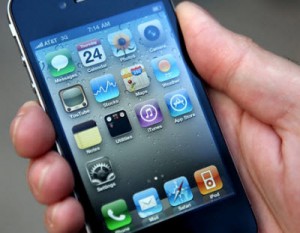 2. iPhone 4 (Apple. $199 to $299, with two-year AT&T service). Apple outdid itself and its competitors again by coming up with the best phone on the market (check out our iPhone 4 review). The high-resolution retina display delivers sharp images, and the combo camera and camcorder can capture great images to display on the device. It does video calls, multitasking, high-definition video, and the reception problem — known as Antennagate — has pretty much died down, as all you have to do is get a cheap rubber case to ensure your calls don’t get dropped. The wide variety of apps — nearly 300,000 of them — make this phone more useful to people who want to have a combination of productive work and diverting entertainment in one device. Games, books, and location apps are taking off like wildfire with iPhone consumers. Apple is adding new functionality with its improved operating system. You can find games more easily with Game Center, browse through iAds, and organize your apps with ease.
2. iPhone 4 (Apple. $199 to $299, with two-year AT&T service). Apple outdid itself and its competitors again by coming up with the best phone on the market (check out our iPhone 4 review). The high-resolution retina display delivers sharp images, and the combo camera and camcorder can capture great images to display on the device. It does video calls, multitasking, high-definition video, and the reception problem — known as Antennagate — has pretty much died down, as all you have to do is get a cheap rubber case to ensure your calls don’t get dropped. The wide variety of apps — nearly 300,000 of them — make this phone more useful to people who want to have a combination of productive work and diverting entertainment in one device. Games, books, and location apps are taking off like wildfire with iPhone consumers. Apple is adding new functionality with its improved operating system. You can find games more easily with Game Center, browse through iAds, and organize your apps with ease.
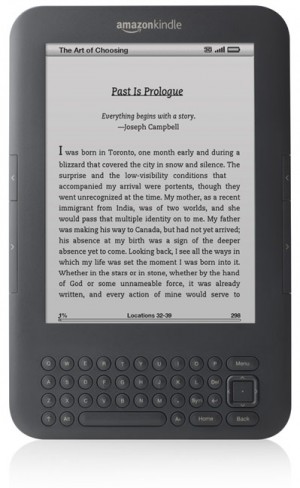 3. Kindle (Third Generation) (Amazon. $139, $179) The Kindle has long been a good gift idea, but it’s even more compelling this year, since Amazon has dropped its price considerably with the introduction of the $139 WiFi-only model. The $179 model with 3G is still a steal compared to its $259 price this time last year. What’s more, the third-generation Kindle offers many improvements over previous versions, including a higher contrast E-Ink screen and an impossibly thin profile. It’s not hyperbole to say that the Kindle is even more portable than a small paperback. Amazon will soon add book lending to the device, so you’ll be able to share books with friends easily. And the widespread availability of Kindle software across other platforms (iPhone, iPad, Android, Mac, PC, and more) means that you’ll always have access to your ebooks.
3. Kindle (Third Generation) (Amazon. $139, $179) The Kindle has long been a good gift idea, but it’s even more compelling this year, since Amazon has dropped its price considerably with the introduction of the $139 WiFi-only model. The $179 model with 3G is still a steal compared to its $259 price this time last year. What’s more, the third-generation Kindle offers many improvements over previous versions, including a higher contrast E-Ink screen and an impossibly thin profile. It’s not hyperbole to say that the Kindle is even more portable than a small paperback. Amazon will soon add book lending to the device, so you’ll be able to share books with friends easily. And the widespread availability of Kindle software across other platforms (iPhone, iPad, Android, Mac, PC, and more) means that you’ll always have access to your ebooks.
 4. Kinect (Microsoft. $149, $299 with Xbox 360 bundle). Microsoft’s motion-control system for the Xbox 360 (which starts at $199) is rough around the edges. It’s not as good as we expected, but we are hard to please and it’s a lot better than other competing products on the market. We’ll wager this sells well because there are an awful lot of consumers who don’t care about Kinect’s weaknesses, which include inaccuracy, weak games (sold separately), and a limited power of recognition. For kids, it’s a magical device that lets them use their bodies to control a game on the TV screen. If you can suspend disbelief and tolerate the inaccuracy, it’s a pretty fun experience. We get a kick out of watching people play the system for the first time. They don’t mind making fools of themselves in front of their family and friends. In that sense, Kinect is inspiring wonder in consumers who were fascinated with Nintendo’s Wii motion-sensing console in 2006. Since Kinect is a software-upgradeable platform, Microsoft has a lot of time to iron out the bugs and then issue software fixes for them later. Also, game developers are likely going to learn how to make great games that compensate for the limitations of the technology. That reduces the risk of buying the system now. For now, this is the closest thing to the gesture-controlled computer that Tom Cruise used in the film Minority Report. For Microsoft, that is high praise. Usually, Microsoft’s devices come nowhere near Apple’s in terms of creating magical experiences. This device may be very hard to find by the end of the holidays, given the high demand for it.
4. Kinect (Microsoft. $149, $299 with Xbox 360 bundle). Microsoft’s motion-control system for the Xbox 360 (which starts at $199) is rough around the edges. It’s not as good as we expected, but we are hard to please and it’s a lot better than other competing products on the market. We’ll wager this sells well because there are an awful lot of consumers who don’t care about Kinect’s weaknesses, which include inaccuracy, weak games (sold separately), and a limited power of recognition. For kids, it’s a magical device that lets them use their bodies to control a game on the TV screen. If you can suspend disbelief and tolerate the inaccuracy, it’s a pretty fun experience. We get a kick out of watching people play the system for the first time. They don’t mind making fools of themselves in front of their family and friends. In that sense, Kinect is inspiring wonder in consumers who were fascinated with Nintendo’s Wii motion-sensing console in 2006. Since Kinect is a software-upgradeable platform, Microsoft has a lot of time to iron out the bugs and then issue software fixes for them later. Also, game developers are likely going to learn how to make great games that compensate for the limitations of the technology. That reduces the risk of buying the system now. For now, this is the closest thing to the gesture-controlled computer that Tom Cruise used in the film Minority Report. For Microsoft, that is high praise. Usually, Microsoft’s devices come nowhere near Apple’s in terms of creating magical experiences. This device may be very hard to find by the end of the holidays, given the high demand for it.
 5. OnLive MicroConsole (OnLive. $99). This system is one of the biggest bargains you’ll come across. Bundled with a wireless controller with fast reaction times, the MicroConsole is disruptive for the game consoles. By attaching it to your TV and the web, you can use it to play high-end video games on a high-definition screen with 1080p resolution. The MicroConsole taps OnLive’s games-on-demand servers. Those servers compute the game images and send them down at high speed over broadband connections to the device, which displays them on the screen. Normally, the game consoles do all of the heavy-duty computing. But with server games, the distribution system is all digital. A lot of critics said the technology wasn’t feasible. But OnLive has blown past everyone’s expectations and delivered a high-quality console experience, as you can see in this video. You can boot up the system and start playing a game in about 15 seconds. The box is tiny, and it’s silent. The only hitch right now is that there are 35 games, and you can’t play the hot game of the season, Call of Duty Black Ops, on the Onlive system. You also need a 5-megabit-per-second broadband connection to play HD games on a 40-inch TV. Better content will come, and when that happens, consumers and console makers will finally realize just how disruptive the OnLive system will be.
5. OnLive MicroConsole (OnLive. $99). This system is one of the biggest bargains you’ll come across. Bundled with a wireless controller with fast reaction times, the MicroConsole is disruptive for the game consoles. By attaching it to your TV and the web, you can use it to play high-end video games on a high-definition screen with 1080p resolution. The MicroConsole taps OnLive’s games-on-demand servers. Those servers compute the game images and send them down at high speed over broadband connections to the device, which displays them on the screen. Normally, the game consoles do all of the heavy-duty computing. But with server games, the distribution system is all digital. A lot of critics said the technology wasn’t feasible. But OnLive has blown past everyone’s expectations and delivered a high-quality console experience, as you can see in this video. You can boot up the system and start playing a game in about 15 seconds. The box is tiny, and it’s silent. The only hitch right now is that there are 35 games, and you can’t play the hot game of the season, Call of Duty Black Ops, on the Onlive system. You also need a 5-megabit-per-second broadband connection to play HD games on a 40-inch TV. Better content will come, and when that happens, consumers and console makers will finally realize just how disruptive the OnLive system will be.
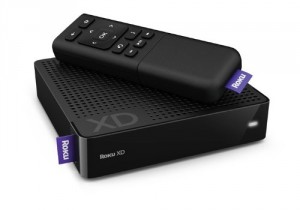 6. Roku XD (Roku. $80) Roku’s latest generation devices are cheaper and more capable than anything the company has produced before — giving you little reason not to pick one up if you still need a way to watch Netflix streaming video on your TV. The XD is the mid-range offering in Roku’s lineup, but there’s also the cheaper $60 Roku HD, or the top-end $100 Roku XDR. We like the XD because it gives you pretty much all the features you would need, and it’s a much better value than the $100 Apple TV. It offers a better Netflix experience than the Apple TV, as well as other services like Hulu Plus that Apple doesn’t offer yet. While you don’t have the convenience of iTunes purchases on the Roku, you have easy access to TV shows and movies via Amazon’s video on demand store.
6. Roku XD (Roku. $80) Roku’s latest generation devices are cheaper and more capable than anything the company has produced before — giving you little reason not to pick one up if you still need a way to watch Netflix streaming video on your TV. The XD is the mid-range offering in Roku’s lineup, but there’s also the cheaper $60 Roku HD, or the top-end $100 Roku XDR. We like the XD because it gives you pretty much all the features you would need, and it’s a much better value than the $100 Apple TV. It offers a better Netflix experience than the Apple TV, as well as other services like Hulu Plus that Apple doesn’t offer yet. While you don’t have the convenience of iTunes purchases on the Roku, you have easy access to TV shows and movies via Amazon’s video on demand store.
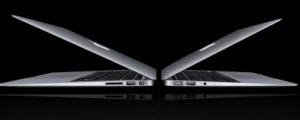 7. MacBook Air (Apple. $999 to $1,599) Much like the iPad, this device blurs the line between work and play. But it has a lot of the features that the iPad ought to have, such as universal serial bus (USB 2.0) ports and full browsers. It’s great for entertainment because it has the full Mac OS operating system and all of its applications. It can also run Microsoft Office and other productivity apps. The device uses flash memory instead of a hard drive. That means you can turn it on instantly and it’s fast. You can switch back and forth between fun and work without having to reboot or wait a long time. That speed is a requirement for any device that purports to straddle the line between work and play. The MacBook Air comes with either an 11.6-inch screen or a 13.3-inch model. It’s only 0.68 inches thick at the thickest part and just 0.11 inches at its thinnest. It weighs 2.9 pounds, but it’s made out of solid aluminum so it’s sturdy. The size matters because you can carry it around and it won’t give you a backache. The FaceTime video phone app lets you call people with an iPhone 4 and chat with live video. It’s beautiful enough that people will stop and ask you about it. So it can’t be bad for your social life either.
7. MacBook Air (Apple. $999 to $1,599) Much like the iPad, this device blurs the line between work and play. But it has a lot of the features that the iPad ought to have, such as universal serial bus (USB 2.0) ports and full browsers. It’s great for entertainment because it has the full Mac OS operating system and all of its applications. It can also run Microsoft Office and other productivity apps. The device uses flash memory instead of a hard drive. That means you can turn it on instantly and it’s fast. You can switch back and forth between fun and work without having to reboot or wait a long time. That speed is a requirement for any device that purports to straddle the line between work and play. The MacBook Air comes with either an 11.6-inch screen or a 13.3-inch model. It’s only 0.68 inches thick at the thickest part and just 0.11 inches at its thinnest. It weighs 2.9 pounds, but it’s made out of solid aluminum so it’s sturdy. The size matters because you can carry it around and it won’t give you a backache. The FaceTime video phone app lets you call people with an iPhone 4 and chat with live video. It’s beautiful enough that people will stop and ask you about it. So it can’t be bad for your social life either.
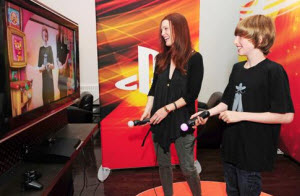 8. Sony PlayStation Move (Sony. $49 and up). The PlayStation Move is Sony’s big bet on motion controls for the Playstation 3 (which starts at $299). Based on our interview with motion-control guru Richard Marks, Sony didn’t think that 3D motion cameras, such as those used in Kinect, were ready for prime time. Instead, Sony stuck with a wand-like device you hold in your hand. It has traditional buttons, but it also has a variety of tracking sensors — a light bulb, an accelerometer, a gyroscope and a compass — that give it pinpoint accuracy in tracking where your hand is moving. As such, it could prove to be much more accurate than either the Nintendo Wii or the Kinect. So far, Sony has a good combination of hardcore and casual games for the Move. But it lacks a killer application to really make the device sell. We’re not sure if Sony stretched far enough to go beyond Nintendo and to match Microsoft with the Move. If you’re a Sony fan, this could be your best purchase for the holidays. But Microsoft’s Kinect will probably stretch the imagination farther with its no-controller motion-sensing system. With Move, you get a better experience if you hold two controllers in your hand, and you also have to have a PlayStation Eye camera. When you add up all of those costs, you could spend $130 or more on the whole system.
8. Sony PlayStation Move (Sony. $49 and up). The PlayStation Move is Sony’s big bet on motion controls for the Playstation 3 (which starts at $299). Based on our interview with motion-control guru Richard Marks, Sony didn’t think that 3D motion cameras, such as those used in Kinect, were ready for prime time. Instead, Sony stuck with a wand-like device you hold in your hand. It has traditional buttons, but it also has a variety of tracking sensors — a light bulb, an accelerometer, a gyroscope and a compass — that give it pinpoint accuracy in tracking where your hand is moving. As such, it could prove to be much more accurate than either the Nintendo Wii or the Kinect. So far, Sony has a good combination of hardcore and casual games for the Move. But it lacks a killer application to really make the device sell. We’re not sure if Sony stretched far enough to go beyond Nintendo and to match Microsoft with the Move. If you’re a Sony fan, this could be your best purchase for the holidays. But Microsoft’s Kinect will probably stretch the imagination farther with its no-controller motion-sensing system. With Move, you get a better experience if you hold two controllers in your hand, and you also have to have a PlayStation Eye camera. When you add up all of those costs, you could spend $130 or more on the whole system.
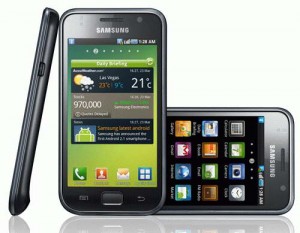 9. Samsung Galaxy S (Samsung. $199 with two-year contract from AT&T, T-Mobile, Verizon, Sprint) Out of nowhere, Samsung unleashed some of the most compelling Android smartphones ever seen — and it also had an ambitious plan to bring them to all major US carriers. Samsung’s Galaxy S phones aren’t the fastest or most fully featured Android phones out there, but they are a happy medium between mainstream Android handsets, and monstrously large phones like the Evo 4G. All of the Galaxy S phones feature a 4-inch Super AMOLED screen, which is by far the brightest cellphone display available, and run Samsung’s 1 gigahertz Hummingbird processor. If you’re having trouble choosing an Android phone at the moment, it’s hard to go wrong with any of the Galaxy S options. And yes, even iPhone 4 owners will be envious.
9. Samsung Galaxy S (Samsung. $199 with two-year contract from AT&T, T-Mobile, Verizon, Sprint) Out of nowhere, Samsung unleashed some of the most compelling Android smartphones ever seen — and it also had an ambitious plan to bring them to all major US carriers. Samsung’s Galaxy S phones aren’t the fastest or most fully featured Android phones out there, but they are a happy medium between mainstream Android handsets, and monstrously large phones like the Evo 4G. All of the Galaxy S phones feature a 4-inch Super AMOLED screen, which is by far the brightest cellphone display available, and run Samsung’s 1 gigahertz Hummingbird processor. If you’re having trouble choosing an Android phone at the moment, it’s hard to go wrong with any of the Galaxy S options. And yes, even iPhone 4 owners will be envious.
 10. Nook Color (Barnes and Noble. $249) Just when you thought Barnes and Noble’s Nook e-reader was in serious trouble — given the new Kindle’s better display and cheaper price — the company unleashed the shockingly inexpensive Nook Color, a device that appears to be part e-reader, part tablet, and all Android. The Nook Color drops the E-Ink display of the original and instead opts for a 7-inch touchscreen LCD display. It’s half the price of the iPad, and more portable to boot. It’s also a better option for younger kids, as it’s far more rugged than Apple’s tablet. It’s not a genuine Android tablet, since it won’t run Android apps, but B&N says it will let developers create apps specifically for the Nook Color. We still prefer the Kindle for pure text reading, but if you’re interested in electronic magazines, or a way to enjoy colorful children’s e-books, the Nook Color is by far one of the best values this season.
10. Nook Color (Barnes and Noble. $249) Just when you thought Barnes and Noble’s Nook e-reader was in serious trouble — given the new Kindle’s better display and cheaper price — the company unleashed the shockingly inexpensive Nook Color, a device that appears to be part e-reader, part tablet, and all Android. The Nook Color drops the E-Ink display of the original and instead opts for a 7-inch touchscreen LCD display. It’s half the price of the iPad, and more portable to boot. It’s also a better option for younger kids, as it’s far more rugged than Apple’s tablet. It’s not a genuine Android tablet, since it won’t run Android apps, but B&N says it will let developers create apps specifically for the Nook Color. We still prefer the Kindle for pure text reading, but if you’re interested in electronic magazines, or a way to enjoy colorful children’s e-books, the Nook Color is by far one of the best values this season.
Front photo via Mat Packer
VentureBeat's mission is to be a digital town square for technical decision-makers to gain knowledge about transformative enterprise technology and transact. Learn More
